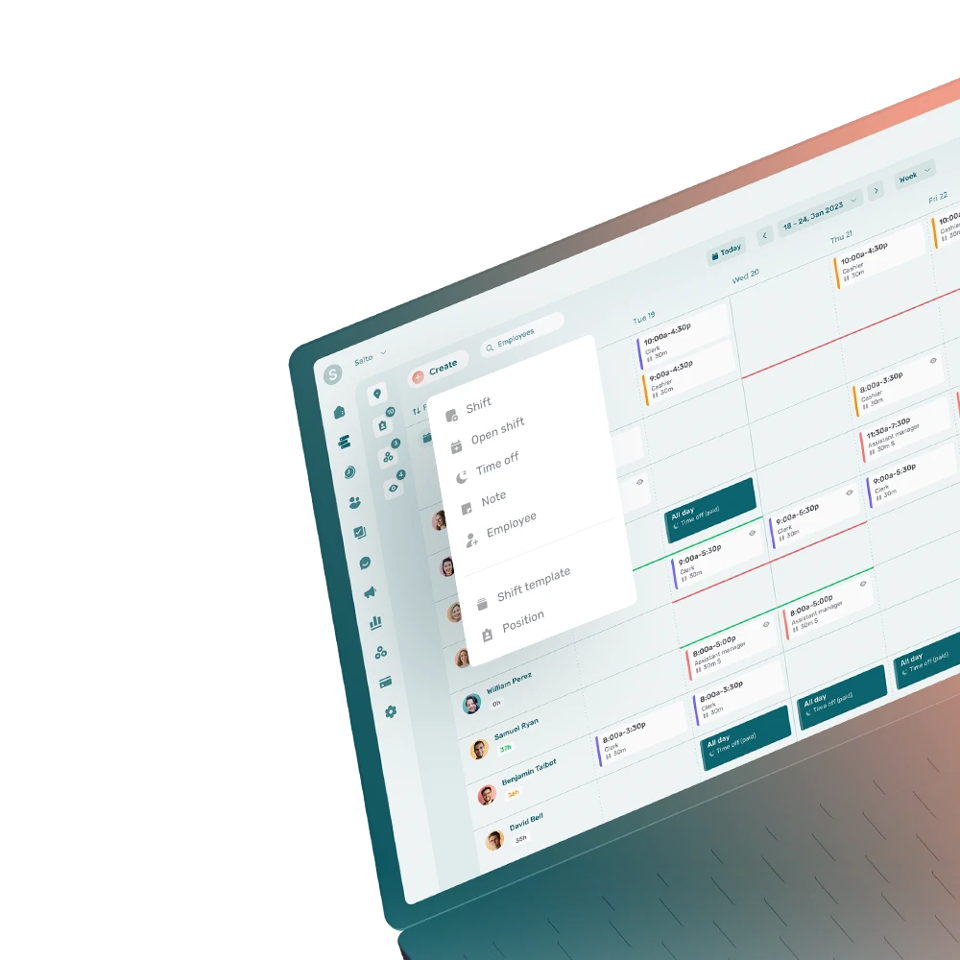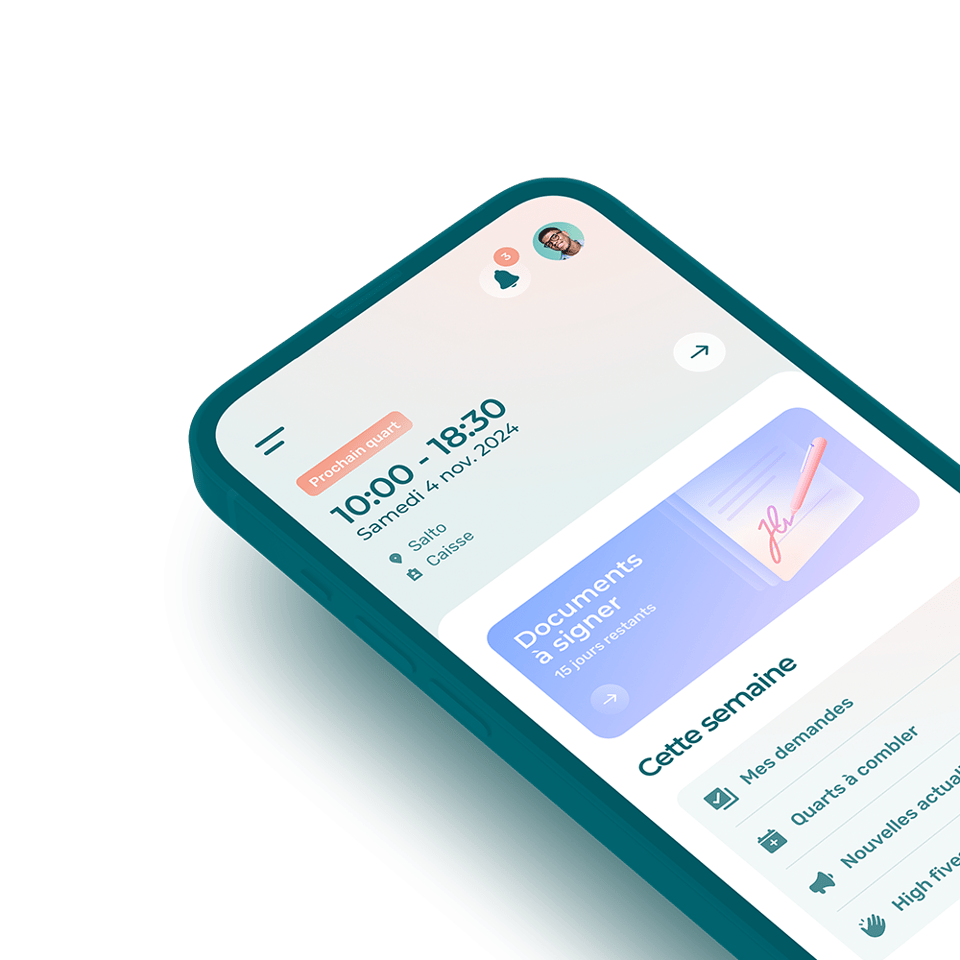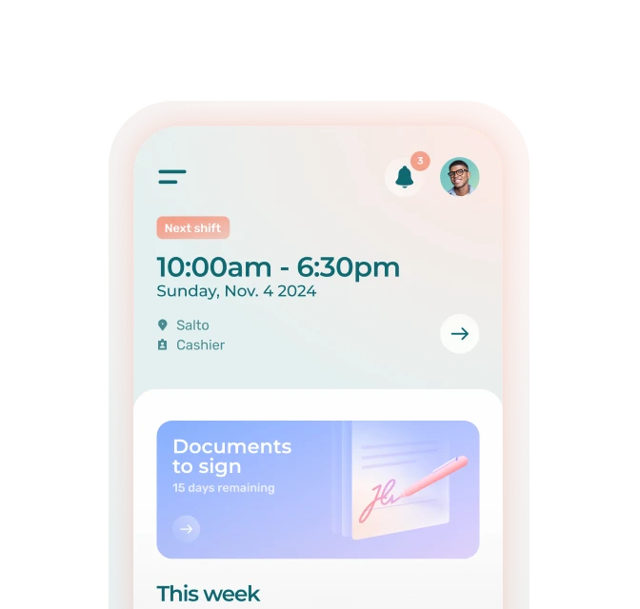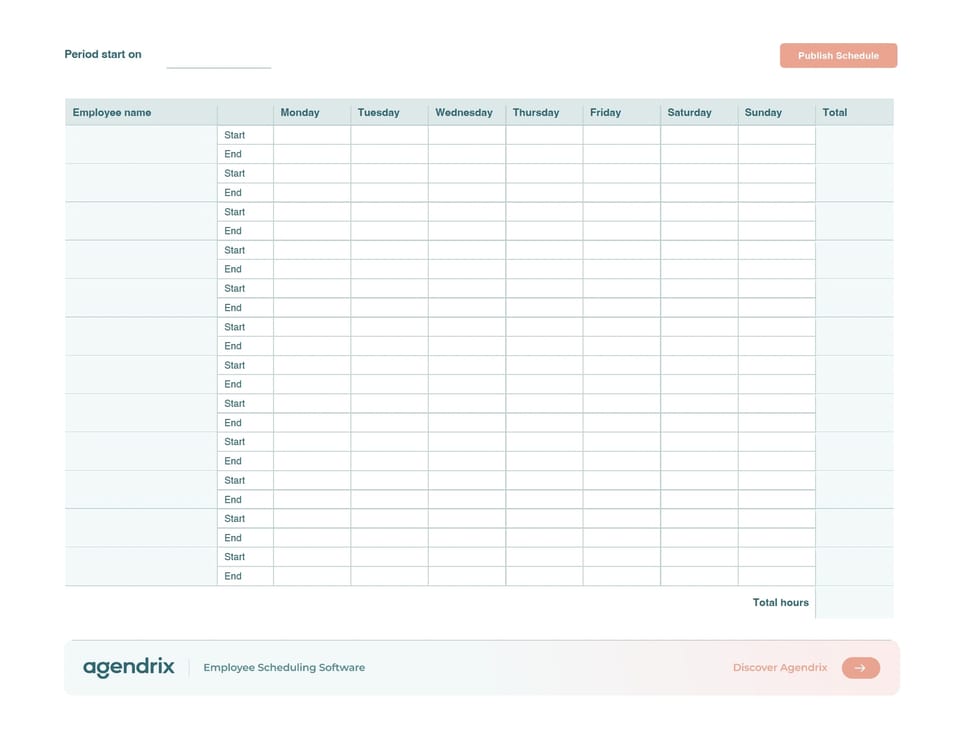Restaurant Work Schedule Template
As a restaurant manager, you can optimize your staff scheduling with this free template. Whether you’re scheduling shifts for waiters or kitchen staff, this easy-to-use tool provides a clear overview of work schedules, employee roles, and labor costs for the entire week. Download it as a Word, Excel, or PDF file.

To which address should we send your resource?
What is a restaurant work schedule?
A restaurant work schedule is a table that provides an overview of employees’ shifts and positions over a full week.
Typically created by the establishment’s manager, a well-structured and comprehensive restaurant work schedule also includes key details such as total hours worked per employee, paid and unpaid breaks, hourly wages, and the total labor cost for the week. For restaurant owners, this last piece of information is particularly useful for balancing staffing expenses with other operational costs, such as supplies and maintenance.
In the restaurant industry, work schedules are usually published every two weeks. Pick the right pattern with these work schedule types.
Plan labor (including tip pooling) + restaurant budget in one place.
How to make a restaurant work schedule in Excel?
Build a weekly grid with daypart templates (brunch/lunch/dinner), use dropdowns for roles and stations, calculate hours automatically (=24*(End-Start)-Break), and track Labor % and SPLH with SUMIFS. Add conditional formatting for breaks/overtime and publish 10-14 days ahead.
Plan wages by role with a restaurant staffing budget template.
To keep Labor % in check, use our restaurant labor cost calculator alongside this template.
How do I make a work schedule for my restaurant?
Use demand-based scheduling: forecast sales/covers by daypart, set Labor % targets, build a Mon–Sun template by role/station using a skill matrix, honor availability/PTO, and publish 10–14 days ahead with managed swaps and compliance checks (breaks, overtime, minors, clopenings). Track SPLH and Labor % weekly to improve.
- Forecast demand: Use POS history by weekday/hour; adjust for seasonality, events, reservations.
- Set guardrails: Target Labor % = Labor Cost / Sales, overtime caps, break rules, minor restrictions, no clopenings (<10–12h rest).
- Create a skill matrix: Map who can open/close, bar, line, expo, host, delivery; note certifications.
- Template by daypart: Brunch/lunch/dinner; define coverage ratios (e.g., 1 server per 4–6 tables; line cooks per projected covers/hour).
- Build the weekly schedule: Assign shifts Mon–Sun by role and station; balance sections and avoid back-to-back closes/opens.
- Fairness & communication: Honor availability and approved PTO; rotate weekends/closings; publish 10–14 days in advance; allow manager-approved swaps with audit trails.
- Monitor & iterate: Track SPLH = Sales / Labor Hours, Labor %, late changes, and call-outs; re-forecast weekly.
Compliance note: Labor laws vary by location. Confirm local requirements for breaks, overtime, predictive scheduling, and minors.
Before publishing, total weekly hours with the employee hours calculator to validate coverage.
Avoid common employee scheduling mistakes as you iterate.
What should be included in a staff schedule?
Include who, when, where, and why: employee name/role, daypart, start-end, break, station/section, manager on duty, coverage counts, availability/PTO, compliance flags (breaks, minors, clopenings, OT), and a notes/hand-off area. Add a summary with total hours, labor cost/%, and SPLH.
Capture actual hours with a restaurant timesheet template (Excel).
- People & roles: Employee name, primary role (Server, Bartender, Line, Host), secondary skill/certifications (e.g., alcohol, food safety).
- Time blocks: Day/date, start-end, paid/unpaid break, daypart (brunch/lunch/dinner/late).
- Where/assignment: Station/section (Bar, Patio, Line1, Host Stand), opener/closer flag, cross-training notes.
- Manager on duty (MOD): Who’s responsible each shift.
- Coverage & targets: Headcount by role per hour,
- Labor % target, SPLH target, special events/reservations.
- Availability & PTO: Approved time-off, availability constraints, on-call list, backup names.
- Compliance: Break requirements, minors rules, no clopenings (<10-12h rest), overtime limits, predictive scheduling windows.
- Communication: Publish date/time, swap policy, contact channel (app/SMS), acknowledgment status.
- KPI summary: Total labor hours/cost, Labor % =
- Labor Cost / Sales, SPLH = Sales / Labor Hours, late changes/call-outs.
- Notes & hand-offs: 86’d items, promos, VIPs, maintenance, side-work checklists.
Privacy tip: keep wage rates off the posted schedule, store payroll preparation data in a secure system.
Distribute tips across shifts with a restaurant tip pool calculator.
How to make a restaurant work schedule?
To make a restaurant work schedule, ask yourself the following questions:
- What are my staffing needs (cooks, waiters, bartenders)?
- What level of customer traffic should I expect at any given time?
- What are my employees’ strengths and weaknesses?
- When are each of my team members available to work?
- Am I fair and consistent in assigning shifts?
- Are there local labor laws to comply with?
- Should I consider using scheduling software to streamline the process?
- How do I get feedback from my employees as far as their schedule goes? How should I make adjustments?
Read more: How to Make a Restaurant Schedule: Our Top 15 Tips
Not sure where software fits in? Learn more about employee scheduling software.
What factors should be considered when creating a restaurant work schedule?
Here are the key elements to consider when creating a restaurant work schedule:
- Schedule start date
- Calendar dates
- Days of the week
- Employee first and last names
- Employee positions (such as chef, cook, kitchen assistant, dishwasher, head waiter, server, bartender)
- Individual employee work shifts
- Days off
- Paid breaks
- Unpaid breaks
- Total weekly work hours scheduled
- Weekly labor cost
Are there different types of restaurant work schedules?
Yes. Restaurant work schedules can be based off various models, including:
- Fixed schedule
- Rotating schedule
- Full-time and part-time schedules
- Weekday and weekend schedules
- Weekly schedule
- Monthly schedule
You can also create your own schedule model based on your needs to simplify workforce management.
If you’re interested in a monthly schedule, check out our employee monthly work schedule template, it might come in handy! And make sure to visit our complete list of restaurant management and scheduling templates.
For a deeper walkthrough, see best restaurant schedule tips.
Why is it relevant to use a work schedule in the restaurant industry?
There are several advantages to using a schedule for restaurant staff:
- Better control over weekly labor costs
- Improved staffing needs management
- Clear overview of employees on duty
- Simplified leave and availability management
- Faster response to unexpected changes
- Greater flexibility for employees
To make scheduling easier, many managers turn to scheduling software like Agendrix, which is built specifically for the restaurant industry. This kind of tool helps streamline key HR processes, including shift scheduling, time tracking, and employee management.
New to the basics? Learn what is a work schedule.
Want to hear what a real restaurant manager thinks of Agendrix? Check out Caroline’s testimonial, she owns two St-Hubert rotisseries!





